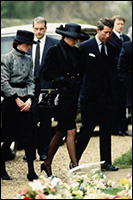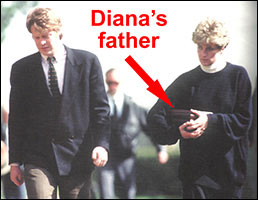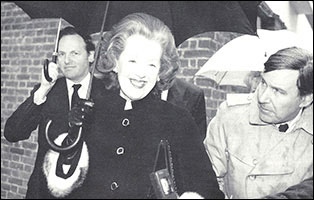| Princess
Diana had a wicked MI6 stepmother named Raine
Spencer who introduced her to MI6 Mohamed Al Fayed!! |
The Spencers arrived in Britannia with William the Conqueror in 1066. At that time England was once again annexed to the iron kingdom of Rome. Instead of eagles, the invading hosts carried crosses. In reality, it was a homecoming, because the Papacy originated in Britannia with Emperor Jesus Constantine.
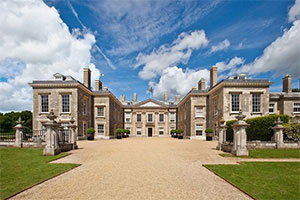 Althorp is the home of the Despenser or Spencer dynasty. |
|
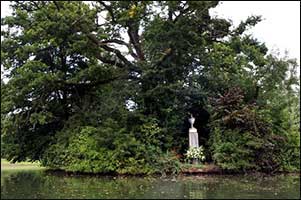 The fake or counterfeit burial place of Princes Diana. |
Here is a quote by Charles Spencer, surviving brother of Princess Diana:
There has been much debate about where the history of my family can be seen to have begun. The version I was told, by Grandfather, was categorical: 'The word "Spencer",' he told me when I was a boy, 'derives from the Norman word for Steward, or Head of Household: "Despenser". Our common ancestor was Steward to the household of William, Duke of Normandy, joining his master at the Battle of Hastings, in 1066, and subsequently settling in England, when the Duke became King of England.' (Spencer, The Spencers, p. 1).
After the conquest of England in 1066, British bluebloods traced their ancestry to William the Conqueror. A captain Robert Spencer fought against general Jackson at the Battle of New Orleans:
While the Napoleonic Wars were still raging, Britain found herself simultaneously at odds with the United States. Bob is the only Spencer to date to have been involved in direct armed conflict with America. His sphere of operations was in, and off the coast of Florida and Louisiana. His ship was part of a small force under Captain the Hon. W. H. Percy which attacked the West Florida stronghold of Fort Bowyer, near Mobile, in September 1814.
Later in the same year Bob was chosen by Sir Alexander Cochrane to land near New Orleans. With his knowledge of French and Spanish, he was instructed to find out what he could about Louisiana, and to secure guides and pilots for the proposed British expeditionary force. However, he was very nearly captured by General Jackson's cavalry, he and his colleague only just getting away in their boat before the enemy arrived at their secret hiding place. (Spencer, The Spencers, p. 205).
That captain stayed in the U.S. after the disastrous defeat, stirring up the native Americans to massacre the pioneers.
The most notorious Spencer of them all was the Jesuit Ignatius Spencer who was obsessed with the "conversion of England." That dynasty did produce some genuine Christians . . . but they were few and far between . . . and usually despised by the rest of the family.
Johnnie Spencer was the human face of the Spencer dynasty!!
Edward John "Johnnie" Spencer, Viscount Althorp, was a scion of the leading British aristocratic family and heir to the family country seat at Althorp. He was also the father of the assassinated Princess Diana. As the surviving son of the 7th Earl Spencer (1892–1975), he inherited the vast Althorp estate when his father died.
 John "Johnnie" Spencer (1924–1992). |
|
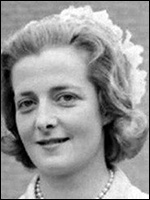 Frances Ruth Roche (1936–2004). |
Frances Ruth Roche–the future mother of Princess Diana–was scheming and ambition and had much closer ties with the British royal family than her husband Johnnie.
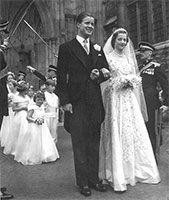 The wedding of Johnnie Spencer and Frances Ruth Roche. |
|
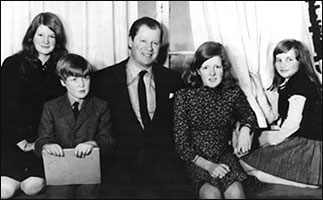 The Spencer family. (L to R) Sarah, Charles, Johnnie, Jane and Diana. |
Johnnie and his children were living a very contented life as Spencer heirs . . . until disaster struck....Frances treacherously departed from her husband and children and started an adulterous affair with a married man in London.
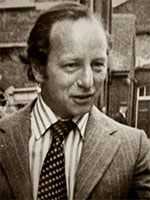 Peter Shand Kydd (1925–2006). |
|
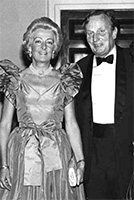 Frances married Peter Shand Kydd in 1969. |
Even though she fought fiercely in court , no judge would award her custody for deserting her husband and children. Peter already had 3 children by a previous marriage so Frances became a wicked stepmother to them also.
Lady Diana Spencer acquired a wicked stepmother in 1976
In 1976, Lady Diana Spencer acquired a wicked STEPmother that she nicknamed "Acid Raine." Her name was Raine Legge and she was married to Gerald Humphry Legge, 9th Earl of Dartmouth. The couple had 4 children. Earl Spencer was devastated by the divorce and needed female help in taking care of the 4 children. It was at that strategic moment that MI6 "Acid Raine" showed up:
By the time Sarah had finished school, there was another woman in her life and her family's – Raine, Countess of Dartmouth. Johnnie had first met Raine before he married Frances, and she had changed little since, almost the spitting image of her famous mother, the romantic novelist Dame Barbara Cartland. Despite her bouffant hairstyle, heavy make-up, and tendency to gush, Raine was not a person to be underestimated, being highly intelligent and absolutely dedicated to her own personal crusades.
She was among the four hundred guests at the party Johnnie gave for Sarah's eighteenth birthday. The event had been planned as a fancy-dress party and Raine managed to ingratiate herself with both daughter and father by arranging a costume for Johnnie as King Henry VIII, and for Sarah one of the dresses worn by Geneviéve Bujold, as Anne Boleyn, in the 1969 film Anne of the Thousand Days. (Riddington & Naden, Frances, p. 81).
Her personal crusade was to gain total control over Johnnie and make sure that he walked one of the Spencer girls down the aisle with the Prince of Wales.
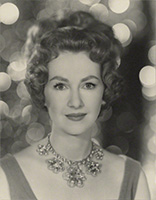 Raine Spencer (b. 1929). |
|
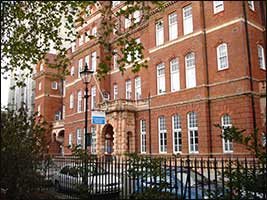 The National Hospital for Neurology and Neurosurgery in London. |
In September 1978, Johnnie had a massive cerebral hemorrhage that almost killed him....It was a terrible blow to Raine as she would not inherit the Althorp estate if he died. Under the British law of primogeniture, the estate would go to his son Charles.
After his stroke, Johnnie was taken to Northampton General Hospital, a 6-mile journey from Althorp. The doctors there told her his case was hopeless and that he would never recover. In desperation, she put him in an ambulance and made a 2-hour drive to the National Hospital for Neurology and Neurosurgery in London.
Raine had a new drug named Aslocillin flown in from Germany. That drug had only been tested on RATS and was not licensed for use in the U.K.
 Johnnie and Raine outside Althorp, Jan. 1981. |
|
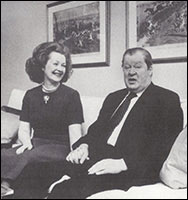 Johnnie and Raine in Munich, June 1981. |
After Johnnie "recovered," the looting of Althorp began in earnest. Most of the priceless treasures that the Spencer dynasty had accumulated over the centuries were sold off.
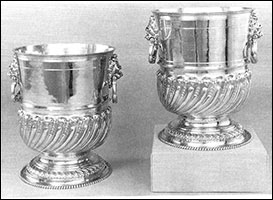 A pair of 17th-century solid gold wine coolers from the Marlborough collection. |
|
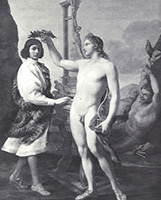
Apollo Crowning the Musician Marcantonio Pasqualini by Andrea Sacchi. |
The departure of the paintings from Althorp was the signal for a selling frenzy, as treasures great and small were sold to the Bond Street dealers:
The ruthless Raine became very rich indeed from the sale of the Althorp inheritance.Timothy Clifford, director of the National Galleries of Scotland, called the rape of Althorp 'one of the great tragedies of the eighties', while Robert Simon, editor of the connoisseurs' Apollo Magazine, thought it 'the worst scandal that has happened to a country house in the last century. No one has put their hands on a collection and dealt with it so ruthlessly.' (Pearson, Blood Royal, p. 239).
Lady Diana walked her father down the aisle at Saint Paul's Cathedral!!
If Johnnie Spencer had died in September 1978, there would be no fairy tale wedding of Diana Spencer to the Prince of Wales.
With a little help from her fellow MI6 agents, and the vast fortune from the sale of the Althorp treasures, she was able to bring Diana and Charles together.
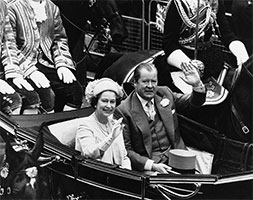
Earl Spencer and Queen Elizabeth II on the way to the fairy tale wedding. |
|
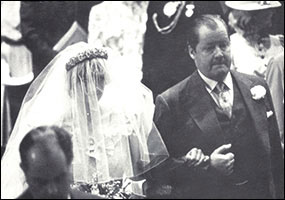 Diana walking her father down the aisle at Saint Paul's Cathedral. |
Leaning heavily on his daughter, it took a Herculean effort to walk down the short isle:
Unfortunately, the only person who could have prevented her from entering the Windsor minefield was mentally incapacitated by his stroke.When all was ready, father and daughter began to slowly climb to the cathedral door. Johnnie faltered briefly on one of the steps and commentators and spectators the world over held their breath. But he quickly recovered.
It took them three and a half minutes to walk down the 625-foot aisle of the great cathedral to the triumphant strains of Jeremiah Clarke's 'Trumpet Voluntary,' Leaning heavily on Diana's arm, Johnnie walked slowly and deliberately, making no attempt to hide his intense concentration. The world watched and waited, but his step did not waver. It was one of the ceremony's most moving moments.
A close relative says: 'No one can really know the sheer effort it took him on that wedding day. All the family willed him up those steps. He was so determined not to be taken up in a wheelchair even if he snuffed it at the end of the day.' (Levin, Raine and Johnnie, p. 172).
Princess Diana's father died unexpectedly in March 1992
On March 29, 1992, 68-year-old Earl Spencer was in the Wellington Hospital in London, recovering from mild pneumonia. His condition was not considered life threatening so Prince Charles, Princess Diana, and their children had gone on a skiing trip to Switzerland.
Suddenly, he suffered a massive fatal heart attack. It was a very timely death indeed.
|
Cremation is very convenient if a person dies by foul means because the entire body is consumed by the burning flame. One person who was definitely not mourning was Raine herself.
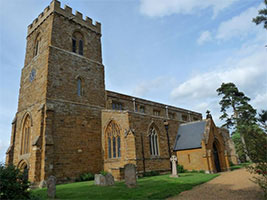 St. Mary the Virgin Church. |
|
When Johnnie Spencer died, his only surviving son Charles inherited his title and the Althorp estate. His will left £4,000,000 to Raine, plus sundry properties. His 3 daughters received very little money from his estate. Incredibly, Diana and Raine had a reconciliation after the funeral and they became close friends as the years passed.
Princess Diana was refused permission to live at Althorp!!
Coincidently, Johnnie Spencer died at a very inconvenient time for Princess Diana. It was about that time that her fairy tale marriage to Prince Charles finally ended tragically, and she was anxious to move out of her Kensington Palace prison. Here is a quote from Diana's bodyguard:
By the spring of 1993 Diana was becoming increasingly uneasy with having to live at Kensington Palace, surrounded by police surveillance cameras, and with her estranged husband's mainly disapproving relations as close neighbors. She longed to break free and have a place that she could truly call her own. So when her brother, Earl Spencer, telephoned out of the blue and offered her the use of the Garden House at Althorp, her ancestral home, she was both pleased and excited. I was dispatched to Northamptonshire to investigate security, and found it perfect. It would have given her the privacy she desired. Not overlooked by any other building on the estate and with a small house adjacent to it which could be used for the duty protection officer, the four-bedroomed Garden House suited all her requirements perfectly. Matters reached a stage where she even contacted an interior designer and picked out her colour scheme for the interior. Sadly, after building up her hopes her brother telephoned to say that he was no longer happy about the idea because he was uneasy about the security presence at Althorp. She was devastated. Unsurprisingly, this disappointment led to a coolness between Diana and her brother for a few months, but it also strengthened in her mind the idea of ridding herself of police protection. (Wharfe, Diana: Closely Guarded Secret, pp. 206-207).
With the Althorp estate now in his possession, Charles could deny his older sister Diana a house on the estate.
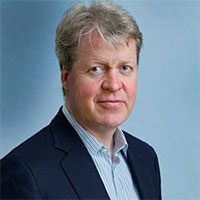 Charles Spencer (b. 1964) refused his sister permission to live at Althorp. |
|
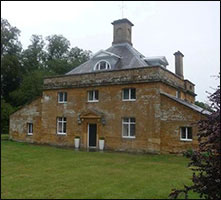 The Garden House at Althorp was supposed to be Diana's new home. |
Diana's pleading letters were returned unopened by her own brother:
She was happy at the thought of having her own country home at last, and where better than in the grounds of her ancestral home close to the brother she had always loved? In her excitement she sought the advice of her friend, the interior decorator, Dudley Poplak, took the princes to see it, and started making plans and choosing furniture and decorations. It had to be done swiftly as she wanted the house to be ready for the Easter holidays in April. But before this could happen, her brother had second thoughts and changed his mind.
Charles Spencer was particularly worried by the problem of security for his own family, as well as the invasion of his privacy. But Diana, who had set her heart on the house, became distraught. In retrospect it does appear a great missed opportunity, for a home at Althorp would have helped her to rebuild her life in close contact with Charles and her family, thus giving her and the children the stability they badly needed. But it was not to be. Charles Spencer was obdurate and, despite her pleas, returned her angry letters unopened. (Pearson, Blood Royal, p. 162).
That decision to force Diana to remain living in London proved fatal for the princess.
Raine introduced Diana to fellow agent Mohamed Al Fayed in 1996
Diana always HATED Raine passionately until just after the funeral of her father. Then they became close "friends." After her divorce from Prince Charles became final in 1996, she introduced him to fellow MI6 agent Mohamed Al Fayed:
Since their reconciliation, Raine had become increasingly important in Diana's life. As a woman of the world she was always there with practical advice, and soon they were speaking daily on the telephone and lunching together almost every week, either at the Connaught Hotel or Claridges. Then, one fateful day, Raine took Diana for lunch at Harrods to meet her old friend, the Chairman, Mohammed al Fayed. Over lunch al Fayed talked with pride about the close friendship he had always had with her father and with Raine. He told her, 'My old friend, Earl Spencer, was like a brother to me. On his deathbed he asked me to take care of his family.' This was a promise he would like to keep. (Pearson, Blood Royal, p. 264).
Diana did receive a £17,000,000 settlement after the divorce but Mohamed's wealth left her breathless.
 Mohamed Al Fayed in 1997. |
|
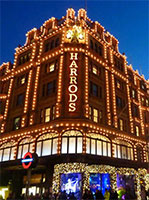 Harrods Department Store was owned by Mohamed Al Fayed. |
After that first meeting, Diana had more lunches at Harrods:
Al Fayed could be immensely charming and was, of course, very, very rich. He made sure that any contact with Diana came through Raine, and whenever Diana visited Harrods, he was always there to greet her in person and to make a fuss of her, just as he had with Johnnie. He insisted that it was his privilege to do so. By now he had appointed Raine to a non-executive directorship of Harrods and he offered a similar position to Diana. She was tempted, but in the end reluctantly refused. But she did not refuse his offer in 1997 to spend a luxurious holiday with al Fayed and his family at his villa in the South of France. By accepting this invitation, Diana's fate was sealed. (Pearson, Blood Royal, p. 265).
Very slowly Diana was being drawn into the spiders web from which there was no escape.
 Dodi Fayed (1955–1997). |
|
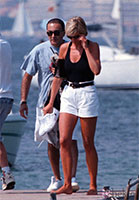 Diana and Dodi just days before her assassination. |
Incredibly, Diana did find a fake or counterfeit burial place on an island in the middle of a lake at Althorp.
Vital links
References
Bradford, Sarah. Diana. Penguin Books, Strand, London, U.K., 2006.
Levin, Angela. Raine And Johnnie: The Spencers and the Scandal of Althorp. Weiderfeld & Nicolson, London, 1993.
Riddington Max, & Naden, Gavan. Frances: The Remarkable Story of Princess Diana's Mother. Michael O'Mara Books, London, U.K., 2003.
Pearson, John. Blood Royal: The Story of the Spencers and the Royals. HarperCollins, London, U.K., 1999.
Spencer, Charles. The Spencers: A Personal History of an English Family. St. Martin's Press, New York, 1999.
Roche, Mary Burke. Call Me Maurice: The Life and Times of Lord Fermoy, 1885–1955. ELSP, Jersey, U.K., 2008.
Wharfe, Ken. Diana: Closely Guarded Secret. Michael O'Mara Books Ltd., Tremadoc Road, London, U.K., 2002.
Copyright © 2016 by Patrick Scrivener
